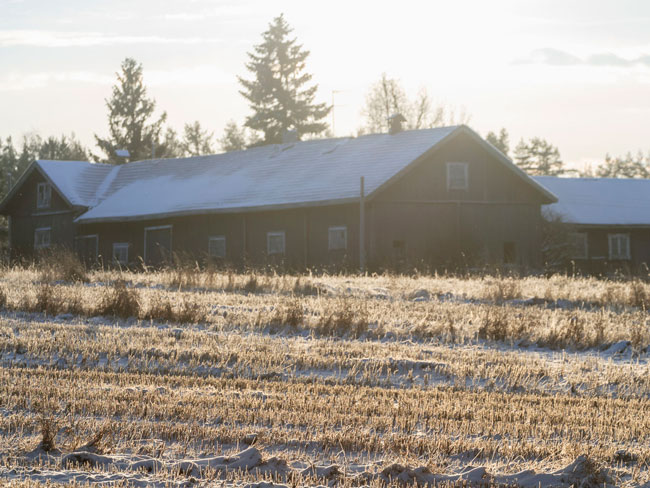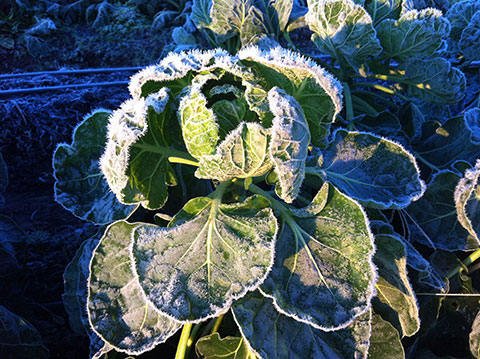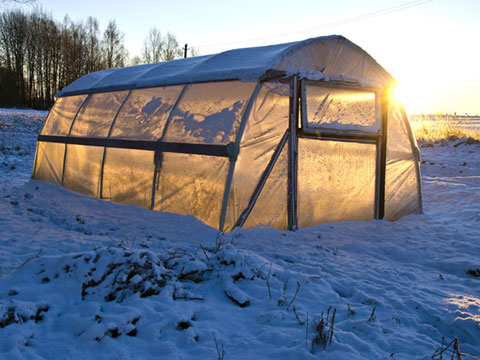Winter on the Farm
- By Heidi Lewis
- Reading Time: 4 mins.
In seed time learn, in harvest teach, in winter enjoy.
—William Blake
 Winter is finally here in drought-stricken California, and we’ve gotten a break from all that balmy, summerlike weather we’ve been experiencing. Hello, rain! Hello, frost! Hello, fog!
Winter is finally here in drought-stricken California, and we’ve gotten a break from all that balmy, summerlike weather we’ve been experiencing. Hello, rain! Hello, frost! Hello, fog!
Although we welcome all precipitation, most farms probably won’t be seeing any of the white stuff. The fertile food-bearing land of California lies mostly below 2,000 feet in elevation, the low mark for most snowfall. California hills are dusty brown until the first few soaks of winter rain turn them a verdant green.
Because the winters are not extremely cold for most farms in California, most of the townsfolk where I live in Sonoma County won’t change their regimen too much as December settles in—maybe they’ll dig out an extra sweater or find a new angle for squinting through the early sunset piercing a dusty windshield. Instead of donning snow gear, we experience the season’s impact through our food choices. Fall’s jewels of winter squash and root veggies inspire us to delve into our collections of comfy and nourishing recipes.
Want farm-fresh fruit?
We've got you covered. All Year Round
All Year Round
Cutting into a golden kabocha squash, I think of the farmer who grows my food and how the seasons color her days. When I ask Elizabeth Kaiser, who farms Singing Frogs Farm in Sebastopol, CA, what changes for her in winter, she reminds me that they farm row crops all year, but adds, “Well, we slow down a bit because of the cold and rain, but mainly because of the day length.”
When your productivity is pegged to photosynthesis, and the peak day length of 14 hours, 51 minutes at the summer solstice dwindles to 9 hours, 29 minutes at the winter solstice, vegetable growth slows down even without snow: summer kale grows three times as fast as winter kale. The plants don’t need the “spring forward, fall back” of daylight saving time—they work directly with el sol.
For California veggie farmers who engage in a year-round growing season, winter means spending time in the greenhouse tending to hardy lettuces and brassicas, such as broccoli, cabbages, and cauliflower. These greenhouses are not tropical like the Conservatory of Flowers in San Francisco’s Golden Gate Park, where you need to check your coat even in winter. Instead, the cold comes up through the ground, chilling your feet.
In the field, farmers use polyurethane-covered hoop houses and high tunnels to provide protection for winter crops from the crushing rains and frost.
Want farm-fresh fruit?
We've got you covered.Time to Go Dormant
Out in the orchards, farmers such as Lucy and Torrey Olson of Gabriel Farm in Sebastopol, CA, bring in the last of the late-season crops, like persimmons and pineapple guavas, in late October. On a busy Sunday at their farm store near the end of the season, Lucy was multitasking: greeting farm visitors and selling jams, juices, and special pear brandy. “In winter we quiet down—it’s when the trees go dormant.” On their to-do list is repairing tools for pruning, as well as seeding the cover crop between the tree rows. In December and January, they close to the public so they can give more attention to the off-farm and civic jobs they hold.
Livestock farmers such as Betty Hui and Dick Blair of Bear Track Farm in Garden Valley, CA, ready their farms for the winter by fertilizing and seeding pastures before the rain. Ranchers get the coziest of winter chores: they can choose to have their animals calve or lamb in the winter so the newborns can spend their childhood and adolescence feasting on the spring grass. For the shepherd, this means long winter nights in a warm barn, looking after nervous moms and new babies.
 Let It Rain but Not Scour
Let It Rain but Not Scour
Winter rains and the imminent El Niño predicted for the Pacific coast are topic number one for Western farmers. They need water falling on their land to recharge their wells and aquifers—but not to erode any soil. The pre-rain winter chore list might include clearing out culverts, spreading hay on bare slopes, and cutting contour channels to direct the flow of water. Years of good soil practices like putting organic matter back in the soil and cover-cropping will keep precious water from running off to rivers and, ultimately, the ocean.
The rain has other benefits as well. As Charlie the Llama, the newsletter author for Singing Frogs Farm, notes, “During dry periods, many plants release oils called petrichor, which, when wetted by the rains, release a beautiful aroma of life. Likewise, further aromatic compounds called geosmin are made by actinomycetes living in the soil and are released when the soil is wetted by the rains.”
A long day of outdoor work can chill a body to the bone, but the pleasure of coming home to a warm hearth and food that you’ve raised yourself can bring a lot of comfort during the cold, dark winter.
Want farm-fresh fruit?
We've got you covered.
Heidi Lewis writes about farms, bees, and fruit from her home in Sonoma County, CA. She’s been with The FruitGuys since they were FruitKids.


